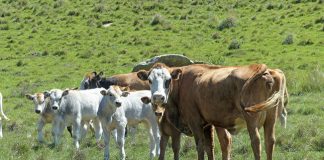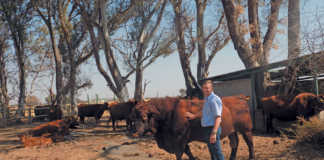Denys Wells farms in the Alexandria district between Port Elizabeth and Port Alfred in the Eastern Cape. Ticks became a major problem for his pure and crossbred Angus cows in the early 1990s, when they developed resistance to synthetic pyrethroid products.“For about 14 years we used Triatix with great results. But then we began to notice resistance,” Denys recalls.
“Fortunately, I’m not the kind of farmer who likes to chop and change products, so I could still use organophosphates, but that only worked for about 12 months.”Denys’ dip advisor suggested the “synergistic” option – combining synthetic pyrethroids with amidens. This worked for about 18 months. But soon blue ticks were everywhere and Denys started losing livestock to redwater and gall sickness. To make matters worse, there was a drought.
Designing a tick-control strategy
Help came in the form of Pierre van Niekerk, a parasite management researcher from Pretoria who was inviting farmers interested in tick research to contact him. “Pierre and his team visited my farms, harvested some ticks and found that the ticks had a resistance to all three groups of dip,” says Denys. “Pierre designed a custom tick-control strategy for me.”
Pierre’s approach worked and Denys reckons the problem is now under control. “A planned strategy is the way forward for farmers who want to control external parasites,” he says. “Take the time to harvest ticks, have them analysed to determine resistance, and have an independent specialist advise you on a strategy, evaluate progress and adapt the strategy if necessary.”Pierre agrees. “When I started working with Denys, the ticks on his farm had an average resistance of over 90% to all the dips on the market.
“When we last checked, the resistance had dropped to 30% to 50%. That’s really good news, because although Denys has an outstanding Angus stud, he was selling fewer animals because of the high tick count.”Denys’s basic mistake was dipping too often. “Now he produces ‘clean’ beef, and by using less dip, he’s also helping conserve the environment,” says Pierre.“His clients know exactly what diseases his animals can tolerate. They also know these cattle are good performers that have developed a natural resistance to ticks.”
What farmers need to know
“Farmers need to learn more about preventative measures and the strategic dipping procedures that will help their herds develop tick resistance,” adds Pierre. “The ideal would be to reduce the economic impact of ticks on an animal’s production by reducing their impact on its health, while cutting out labour, and conserving oxpeckers and useful insects.“It’s especially important for farmers to know the degree of ticks’ resistance to ascaricides on their ranch.
You can only do this by using the scientific approach and regularly sending sample ticks to the Pesticide Resistance Testing Facility at the University of the Free State. The results will help you formulate a dipping programme that works on your farm.”With strategic integrated parasite management, where dip cycles are limited to between three and five a year, nothing is left to chance. “Everything is measured and tested so that we can design a plan to overcome problems with minimum dependence on chemicals,” says Pierre.
“This is much better than the old approach to tick control where the aim was simply to eliminate the parasites. That’s impossible as ticks have started building up resistance to chemicals, with major economic implications for farmers in terms of labour, cost of chemicals, waste, and time.”Pierre says the time has come when the consequences of poor tick control practices should result in legal action, as in the case of fires. “Speculators can introduce resistant ticks to a farm or bring in diseases never known to the area. The same problem occurs when a negligent neighbour’s tick-control programme breaks down.”Contact Pierre van Niekerk on 082 220 8386 or e-mail [email protected].
Causes of dipping failures
Parasite management expert Pierre van Niekerk says dipping can fail for a number of reasons:Failing to scientifically test the effectiveness of active ingredients used.Listening to biased advice that aims to sell a specific product rather than to control and break down tick resistance.Home mixtures that don’t work.Poor grazing management.Undue stress, which makes animals more susceptible to disease.Ticks appearing in new localities due to climate change.
Blue tick blues
Every engorged female blue tick seen with the naked eye represents 476 blue ticks on the same animal completing their life cycles. Thus 70 engorged females represent almost 10 000 blue ticks, an astronomical number of resistant ticks ready to multiply further.A single blue tick consumes almost 3mg of blood during its life-cycle. Researchers in Australia have found it has an agent in its saliva that suppresses the animal’s growth and grazing ability. Cattle infected by blue ticks can grow less than 400g per day, compared to healthy ones that can grow nearly 800g a day.













